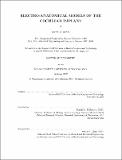| dc.contributor.advisor | Donald K. Eddington. | en_US |
| dc.contributor.author | Whiten, Darren M. (Darren Mark), 1977- | en_US |
| dc.contributor.other | Harvard University--MIT Division of Health Sciences and Technology. | en_US |
| dc.date.accessioned | 2007-08-29T19:05:28Z | |
| dc.date.available | 2007-08-29T19:05:28Z | |
| dc.date.copyright | 2007 | en_US |
| dc.date.issued | 2007 | en_US |
| dc.identifier.uri | http://hdl.handle.net/1721.1/38518 | |
| dc.description | Thesis (Ph. D.)--Harvard-MIT Division of Health Sciences and Technology, 2007. | en_US |
| dc.description | This electronic version was submitted by the student author. The certified thesis is available in the Institute Archives and Special Collections. | en_US |
| dc.description | Includes bibliographical references (p. 211-225). | en_US |
| dc.description.abstract | While cochlear implantation has become the standard care in treating patients with severe to profound sensorineural hearing loss, the variation in benefit (communicative ability) individual patients derive from implantation remains both large and, for the most part, unexplained. One explanation for this variation is the status of the implanted ear which, when examined histopathologically, also displays substantial variation due to both the pathogenesis of hearing loss (etiology, etc.) and pathological changes initiated by implantation. For instance, across-patient variation in electrode position and insertion depth is clearly present, as are differential amounts of residual spiral ganglion survival, fibrous tissue formation and electrode encapsulation, cochlear ossification, and idiosyncratic damage to adjacent cochlear structures. Because of the complex geometric electrical properties of the tissues found in the implanted ear, demonstrating the impact of pathological variability on neuronal excitation, and ultimately on behavioral performance, will likely require a detailed representation of the peripheral anatomy. Our approach has been to develop detailed, three-dimensional (3D) electro-anatomical models (EAMs) of the implanted ear capable of representing the aforementioned patient-specific types of pathological variation. In response to electric stimulation, these computational models predict an estimate of (1) the 3D electric field, (2) the cochleotopic pattern of neural activation, and (3) the electrically-evoked compound action potential (ECAP) recorded from intracochlear electrodes. This thesis focuses on three aims. First, two patient-specific EAMs are formulated from hundreds of digital images of the histologically-sectioned temporal bones of two patients, attempting to incorporate the detailed pathology of each. Second, model predictions are compared to relevant reports from the literature, data collected from a cohort of implanted research subjects, and, most importantly, to archival data collected during life from the same two patients used to derive our psychophysical threshold measures, and ECAP recordings) collectively show a promising correspondence between model-predicted and empirically-measured data. Third, by making incremental adjustments to the anatomical representation in the model, the impact of individual attributes are investigated, mechanisms that may degrade benefit suggested, and potential interventions explored. | en_US |
| dc.description.statementofresponsibility | by Darren M. Whiten. | en_US |
| dc.format.extent | 225 p. | en_US |
| dc.language.iso | eng | en_US |
| dc.publisher | Massachusetts Institute of Technology | en_US |
| dc.rights | M.I.T. theses are protected by copyright. They may be viewed from this source for any purpose, but reproduction or distribution in any format is prohibited without written permission. See provided URL for inquiries about permission. | en_US |
| dc.rights.uri | http://dspace.mit.edu/handle/1721.1/7582 | |
| dc.subject | Harvard University--MIT Division of Health Sciences and Technology. | en_US |
| dc.title | Electro-anatomical models of the cochlear implant | en_US |
| dc.type | Thesis | en_US |
| dc.description.degree | Ph.D. | en_US |
| dc.contributor.department | Harvard University--MIT Division of Health Sciences and Technology | |
| dc.identifier.oclc | 156885801 | en_US |
